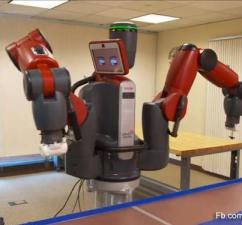 Summary: Employment growth has been the slowest of any post-WW2 recovery. But a greater problem lies ahead — the robot revolution. The next wave of automation, affecting both manufacturing and the far larger population of service workers. Here’s a status report on its early phase, already in motion. At the end are links to other chapters.
Summary: Employment growth has been the slowest of any post-WW2 recovery. But a greater problem lies ahead — the robot revolution. The next wave of automation, affecting both manufacturing and the far larger population of service workers. Here’s a status report on its early phase, already in motion. At the end are links to other chapters.
Contents
- Another person discovers the Robot Revolution
- Examples of automation coming now
- The challenge for every developed nation
- Other posts about the Robot Revolution
- Actroid Sara
The animation above comes from “The Robot Revolution: Your Job May Be Next“, The Fiscal Times, 12 July 2011.
(1) Another person discovers the Robot Revolution
Another person discovers the coming next wave of automation: Barry Ritholtz at The Big Picture:
As the chart {of labor participation} above shows, this peaked in 1999, and has been trending downwards ever since. There are several reasons why this is:
- Demographics of the aging baby boomers, who are retiring, living longer, and impacting this ratio;
- Technology/DotCom collapse eliminated lots of malinvestment driven Tech jobs;
- Financial/Credit crash eliminated lots of malinvestment driven banking/real estate jobs;
- Ongoing outsourcing, globalization, etc.
- Robotics
That last item doesn’t get discussed nearly as much as it should, but the single biggest future trend in the labor force is going to be the ongoing replacement of humans by smart machines.
(2) Examples of automation coming soon
Today it’s just manufacturing, toll booth and parking lot attendants, and people printing-moving-filing paperwork. But the full dimensions of the revolution slowly become visible.
- MINT Plus, the robot floor cleaner
- AI journalist: “In Case You Wondered, a Real Human Wrote This Column“, New York Times, 10 September 2011
- “Clothing Giant H&M Defends ‘Perfect’ Virtual Models“, ABC News, 6 December 2011
- “Robot prostitutes ‘the future of sex tourism’“,
The Dominion Post, 18 April 2012 - “Robot Professors Come With Singularity U’s Massive Upgrade“, Wired, 22 August 2012 — this will be big!
- “Coming soon: Robots that help build buildings“,
Los Angeles Times, 13 November 2012 - “High-School Video Gamers Match Physicians at Robotic-Surgery Simulation“, Slate, 21 November 2012
The robot above is Baxter: “A unique robot with unique features”, from Rethink Robotics:
Baxter is an entirely new type robot that is redefining the way robots can be used in manufacturing environments. It performs a variety of repetitive production tasks – all while safely and intelligently working next to people. How? Baxter exhibits behavior-based ‘common sense,’ capable of sensing and adapting to its task and its environment. It requires no complex programming or costly integration. And with its uniquely low price point, Baxter provides a compelling alternative to low-cost offshoring for manufacturers of all sizes.
(3) The challenge for every developed nation
Automation increases the return to capital, and decreases the return to labor. It will become a major driver of increased inequality. Only slowly does this realization spread, as in the conclusion from this review in the Financial Times by James Crabtree (red emphasis added):
Yet the author’s more basic conclusion – that technological progress is sufficiently rapid that “many present-day organisations, institutions, policies, and mindsets are not keeping up” – is surely right. The result is a conundrum that shares much in common with trade policy. Technology is essential for creating value and raising productivity, but it creates losers as well as winners. These losers are recognised in theory, but too rarely compensated in practice.
This brings the argument back to a more basic problem: fair distribution. Machines work for free, but their benefits end up in someone’s pocket. If technology is indeed speeding up, more of that benefit must be returned to those it affects, especially in the form of investment in human capital. If not, the march of the machines will overtake us sooner than we think.
(4) Other posts about the coming Robot Revolution
- The coming big increase in structural unemployment,
7 August 2010 - The coming Robotic Nation, 28 August 2010
- The coming of the robots, reshaping our society in ways difficult to foresee, 22 September 2010
- Economists grapple with the first stage of the robot revolution, 23 September 2012
- The Robot Revolution arrives & the world changes, 20 Apr ’12
(5) Actroid Sara
Actroid is a android developed by Osaka University and manufactured by Kokoro Company Ltd. (the animatronics division of Sanrio). In most cases, the robot’s appearance has been modeled after an average young woman of Japanese descent. It can mimic such lifelike functions as blinking, speaking, and breathing. Plus the ability to recognize and process speech and respond in kind. (From Wikipedia)











